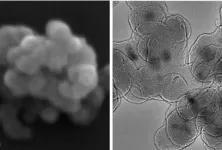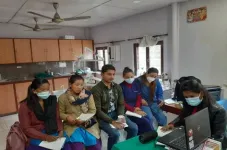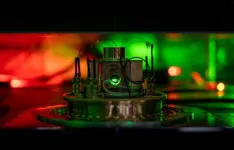(Press-News.org) HOUSTON – (Nov. 27, 2024) – Newly developed halide perovskite nanocrystals (HPNCs) show potential as antimicrobial agents that are stable, effective and easy to produce. After almost three years, Rice University scientist Yifan Zhu and colleagues have developed a new HPNC that is effective at killing bacteria in a biofluid under visible light without experiencing light- and moisture-driven degradation common in HPNCs.
A new method using two layers of silicon dioxide that Zhu and colleagues developed over years of work was used in experiments with lead-based and bismuth-based HPNCs to test their antimicrobial efficacy and stability in water. The study is published in Nano Letters.
HPNCs have unique optical and electrical properties that make them promising candidates for solar power applications, bioimaging and photocatalysis, the acceleration of chemical reactions caused by light in the presence of a catalyst. One such reaction is the production of reactive oxygen species that can inactivate biological contaminants in fluids. However, perovskites are highly prone to degradation in water and biological fluids, limiting their potential in biomedical applications.
“The drawback with these materials has been stability. They’re cheap and easy to make but prone to degradation,” said study co-author Jun Lou, professor and associate chair of materials science and nanoengineering.
The potential for HPNCs to eliminate contaminants from water has taken center stage in recent years with rising concerns about emerging pathogens and increasing rates of antibiotic resistance. Research has found that HPNCs can kill bacteria in aqueous environments by producing reactive oxygen species when exposed to light. Reactive oxygen species like singlet oxygen and hydroxide react with the proteins, lipids and genetic material in bacterial cells, effectively destroying them.
In their early attempts to produce a coated HPNC, the researchers used a single layer of silicon dioxide, a material that would protect the perovskite while allowing light transmission. However, a single layer had limited effectiveness with HPNCs losing 63% of their antimicrobial ability within one day. But a thicker layer could hinder or even prevent HPNCs’ mechanism of action.
“Transfer of energy from perovskites can produce reactive oxygen species,” said Zhu, a postdoctoral research associate in Lou’s lab. “The challenge is to get the right thickness to protect the perovskite while still allowing energy transfer.”
Zhu and colleagues next developed a method that coated the HPNCs in two layers of silicon dioxide. After multiple attempts the research team devised a strategy to consistently get optimal thicknesses for both layers.
“Two coats are more effective than one thicker coat,” said Lou. “It’s not just an extension of thickness. We needed a strategy because the coating has to be processed in specific ways.”
Next the researchers tested the antimicrobial properties and durability of their new double-coated HPNCs. They selected lead and bismuth because HPNCs made with both metals are highly effective under visible light and produce singlet oxygen rather than hydroxide, which can be harmful to other organisms. Zhu and colleagues found that both HPNC varieties showed little to no antimicrobial properties without light. However, under relatively low levels of visible light, both HPNCs destroyed more than 90% of the E. coli bacteria in the solution after six hours. Additionally, both HPNCs showed very little degradation over the four-day test period.
The double-layer silicon dioxide coating proved effective at protecting HPNCs from degradation while allowing energy transfer; however, the researchers also noted an additional benefit from the coating. Analysis found that after four days in water, the lead-based HPNCs had leached only a small amount of lead into their surroundings.
“The leaching amount of lead was well below (World Health Organization) limits,” Zhu said.
The lead-based HPNCs had the best antimicrobial performance, but the bismuth-based materials also performed well.
“The benefit of bismuth is avoiding the use of lead, which is always a concern if put into the body,” said Lou. “You want to find the right balance with a material that has good enough performance and that is safe.”
The study findings show that HPNCs coated with two layers of silicon dioxide have the potential for use as photocatalytic antimicrobial agents. Eliminating organic contaminants like bacteria in water makes these materials a good candidate for use in water treatment. Further research could also lead to HPNCs that can address other water contaminants and even be used in therapeutics in the future. Such materials will need to undergo further testing under real-life conditions in the field and pass safety tests. However, the findings suggest that HPNCs could be useful in a variety of applications.
“After many years of investment in research into these materials, they are approaching reality,” Lou said.
This work was supported by NSF ERC on Nanotechnology-Enabled Water Treatment (NEWT) under award EEC-1449500 and NSF I/UCRC Center for Atomically Thin Multifunctional Coatings (ATOMIC) under award EEC-2113882.
- 30 -
This release can be found online at news.rice.edu .
Follow Rice News and Media Relations via Twitter @RiceUNews .
Peer-reviewed paper:
Double Layer SiO2-Coated Water-Stable Halide Perovskite as a Promising Antimicrobial Photocatalyst under Visible Light | Nano Letters | DOI: 10.1021/acs.nanolett.4c03793
Authors: Yifan Zhu, Hongchen Shen, Qing Ai, Yuren Feng, Bongki Shin, Mateo Gonzales, Yunrui Yan, Ze He, Xiaochuan Huang, Xiang Zhang, Yimo Han, Pulickel M. Ajayan, Qilin Li, and Jun Lou
https://doi.org/10.1021/acs.nanolett.4c03793
END
Our bodies divest themselves of 60 billion cells every day through a natural process of cell culling and turnover called apoptosis.
These cells — mainly blood and gut cells — are all replaced with new ones, but the way our bodies rid themselves of material could have profound implications for cancer therapies in a new approach developed by Stanford Medicine researchers.
They aim to use this natural method of cell death to trick cancer cells into disposing of themselves. Their method accomplishes this by artificially bringing together two proteins in such a way that the new compound switches on a set of cell death genes, ultimately driving tumor cells to turn on themselves. ...
Culturally appropriate women-centred interventions can help healthcare systems respond to domestic violence, research has found. HERA (Healthcare Responding to Violence and Abuse) has been co-developing and evaluating a domestic violence and abuse healthcare intervention in low- and middle-income countries for the past five years. This National Institute for Health and Care Research (NIHR) Global Research Group will report their findings, and publish a PolicyBristol report, at a conference in London today ...
The mission of IQST is to further our understanding of nature and develop innovative technologies based on quantum science by leveraging synergies between the natural sciences, engineering, and life sciences. "Many KIT scientists already successfully support IQST with their expertise as Fellows. All the more I am pleased that the Karlsruhe Institute of Technology is now joining our interdisciplinary centre as an institution," says IQST Director Prof. Stefanie Barz. "This will strengthen networking within the academic quantum community in Baden-Württemberg," emphasizes ...
***Embargoed until November 27 at 11 AM EST***
Chronic diseases like type 2 diabetes and inflammatory disorders have a huge impact on humanity. They are a leading cause of disease burden and deaths around the globe, are physically and economically taxing, and the number of people with such diseases is growing.
Treating chronic disease has proven difficult because there is not one simple cause, like a single gene mutation, that a treatment could target. At least, that’s how it has appeared to scientists. However, research from Whitehead Institute Member Richard Young and colleagues, published in the journal ...
About The Study: This study found a steep decline in cervical cancer mortality among U.S. women younger than 25 years between 2016 and 2021. This cohort of women is the first to be widely protected against cervical cancer by human papillomavirus (HPV) vaccines. The findings from this study in the context of other published research suggest that HPV vaccination affected the sequential decline in HPV infection prevalence, cervical cancer incidence, and cervical cancer mortality.
Corresponding ...
In an international collaboration, researchers at Uppsala University have been able to identify undigested food remains, plants and prey in the fossilised faeces of dinosaurs. These analyses of hundreds of samples provide clues about the role dinosaurs played in the ecosystem around 200 million years ago. The findings have been published in the journal Nature.
“Piecing together ‘who ate whom’ in the past is true detective work,” says Martin Qvarnström, researcher at the Department of Organismal Biology and lead author of the study. “Being able to examine what animals ate and how they interacted with their environment helps us understand what enabled ...
Brain-wide association studies, which use magnetic resonance imaging to identify relationships between brain structure or function and human behavior or health, have faced criticism for producing results that often cannot be replicated by other researchers.
A new study published in Nature demonstrates that careful attention to study design can substantially improve the reliability of this type of research. For the study, Kaidi Kang, a biostatistics PhD student, Simon Vandekar, PhD, associate professor of Biostatistics, and colleagues analyzed data from more than 77,000 brain scans across 63 studies.
The ...
A decade ago, researchers introduced a new model for studying Alzheimer’s disease. Known as “Alzheimer’s in a dish,” the model uses cultures of mature brain cells suspended in a gel to recapitulate what takes place in the human brain over 10 to 13 years in just six weeks. But does the model truly produce the same changes that take place in patients? In a new study, researchers from Mass General Brigham, in collaboration with colleagues at Beth Israel Deaconess Medical Center (BIDMC), created an algorithm to assess, in an unbiased manner, how well models of Alzheimer’s disease ...
About The Study: The results of this study showed an association between high ultraprocessed food intake and active psoriasis status. After adjustments for age, body mass index (BMI), alcohol intake, and comorbidities, the results remained significant, suggesting that ultraprocessed food intake has a proinflammatory action separate from high BMI.
Corresponding Author: To contact the corresponding author, Emilie Sbidian, MD, PhD, email emilie.sbidian@aphp.fr.
To access the embargoed study: ...
About The Study: The findings of this study indicate that preferential promotion of white men within academic medicine continues to persist in the new millennium, with racially and ethnically diverse women experiencing greater underpromotion. To achieve a workforce that reflects the diversity of the U.S. population, this study suggests that academic medicine needs to transform its culture and practices surrounding faculty appointments and promotions.
Corresponding Author: To contact the corresponding author, Lauren Clark, MS, email lclark5@kumc.edu.
To access the embargoed study: ...





